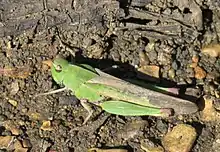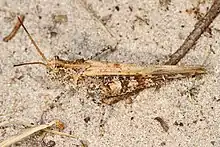Bandwing
Bandwings, or band-winged grasshoppers are the subfamily Oedipodinae[1] of grasshoppers classified under the family Acrididae. They have a worldwide distribution and were originally elevated to full family status as the Oedipodidae.[2] Many species primarily inhabit xeric weedy fields, and some are considered to be important locusts:
- Locusta migratoria: the migratory locust,
- Chortoicetes terminifera: the Australian plague locust.
- Locustana pardalina the brown locust
| Bandwings | |
|---|---|
 | |
| Austroicetes vulgaris | |
| Scientific classification | |
| Kingdom: | Animalia |
| Phylum: | Arthropoda |
| Class: | Insecta |
| Order: | Orthoptera |
| Suborder: | Caelifera |
| Family: | Acrididae |
| Subfamily: | Oedipodinae Walker, 1871 |
| Tribes | |
|
See text | |
| Synonyms | |
|
Locustidae Kirby, 1825 | |
These grasshoppers often have colorful hindwings that may be yellow or red and edged with black. Others have black hindwings with pale edges, and a few species (including the most economically important ones) have clear hindwings. The arolium is extremely small or absent.
Defense
When bandwings feel safe, they appear drab. When they feel threatened, they leap out to reveal bold and bright colors. Some predators might even mistake the Blue-winged grasshopper for butterfly. But when the predator looks for the grasshopper, it is hiding in the grass. Bandwings continue this process if the predator tries to attack them.
Tribes and genera
The Orthoptera Species File lists the following:[3]
Tribe Acrotylini
Auth. Shumakov 1963; distribution: Africa, Europe, Asia, Australia
Tribe Arphiini
Auth. Otte, 1995; distribution: N. America
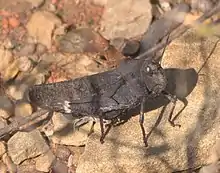
- Arphia Stål, 1873
- Lactista Saussure, 1884 (synonym Rehnita[4])
- Leuronotina Hebard, 1932
- Tomonotus Saussure, 1861
Tribe Bryodemini
Auth. Bei-Bienko 1930; distribution: Europe, Asia

- Andrea (insect) Mishchenko, 1989
- Angaracris Bei-Bienko, 1930
- Bryodema Fieber, 1853
- Bryodemacris Benediktov, 1998
- Bryodemella Yin, 1982 including Bryodemella tuberculata
- Circotettix Scudder, 1876
- Compsorhipis Saussure, 1889
- Uvaroviola Bei-Bienko, 1930
Tribe Chortophagini
Auth. Otte, 1984; distribution: N. America
- Chimarocephala Scudder, 1875
- Chortophaga Saussure, 1884
- Encoptolophus Scudder, 1875
- Shotwellia Gurney, 1940
Tribe Epacromiini
Auth. Brunner von Wattenwyl 1893; distribution: Africa, Europe, Asia through to New Caledonia
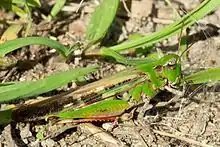
- Aiolopus Fieber, 1853
- Demirsoyus Sirin & Çiplak, 2004
- Duroniella Bolívar, 1908
- Epacromius Uvarov, 1942
- Heteropternis Stål, 1873
- Hilethera Uvarov, 1923
- Jasomenia Bolívar, 1914
- Paracinema Fischer, 1853
- Platypygius Uvarov, 1942
Tribe Hippiscini
Auth. Otte, 1984; distribution: Americas
- Agymnastus Scudder, 1897
- Camnula Stål, 1873
- Cratypedes Scudder, 1876
- Hadrotettix Scudder, 1876
- Heliastus Saussure, 1884
- Hippiscus Saussure, 1861 (monotypic)
- Leprus Saussure, 1861
- Pardalophora Saussure, 1884
- Sticthippus Scudder, 1892
- Xanthippus (grasshopper) Saussure, 1884
Tribe Locustini
Auth. Kirby, 1825; distribution: Africa, Europe, Asia, Australia

- Brunnerella Saussure, 1888
- Chifanicus Benediktov, 2001
- Gastrimargus Saussure, 1884
- Grammoscapha Uvarov, 1942
- Locusta Linnaeus, 1758 (monotypic)
- Locustana Uvarov, 1921
- Oedaleus Fieber, 1853
- Psophus Fieber, 1853 - monotypic Psophus stridulus
- Pternoscirta Saussure, 1884
- Ptetica Saussure, 1884
- Pyrgodera Fischer von Waldheim, 1846
- Scintharista Saussure, 1884
Tribe Macherocerini
Auth. Otte, 1995; distribution: N. America
- Machaerocera Saussure, 1859
Tribe Oedipodini
Auth. Walker, 1871; distribution: N. Africa, Europe, Asia
- Celes (insect) Saussure, 1884
- Mioscirtus Saussure, 1888
- Ochyracris Zheng, 1991
- Oedipoda Latreille, 1829
- Oedipodacris Willemse, 1932
Tribe Parapleurini
Auth. Brunner von Wattenwyl 1893[5] (synonym Parapleuri); distribution: N. America, Europe, Asia
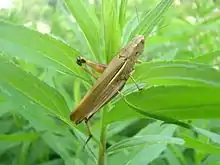
- Ceracris Walker, 1870
- Ceracrisoides Liu, 1985
- Formosacris Willemse, 1951
- Mecostethus Fieber, 1852
- Parapleurodes Ramme, 1941
- Stethophyma Fischer, 1853
- Yiacris Zheng & Chen, 1993
Tribe Psinidiini
Auth. Otte, 1984; distribution: N. America
- Derotmema Scudder, 1876
- Hippopedon Saussure, 1861 (synonym Platylactista[6])
- Mestobregma Scudder, 1876
- Metator McNeill, 1901
- Psinidia Stål, 1873
- Trachyrhachys Scudder, 1876
- Trepidulus McNeill, 1901
Tribe Sphingonotini
Auth. Johnston, 1956; distribution: worldwide, esp. Africa, Europe, Asia

- Conipoda Saussure, 1884
- Conozoa Saussure, 1884
- Cophotylus Krauss, 1902
- Dissosteira Scudder, 1876
- Eusphingoderus Bei-Bienko, 1950
- Heliopteryx Uvarov, 1914
- Helioscirtus Saussure, 1884
- Hyalorrhipis Saussure, 1884
- Microtes Scudder, 1900
- Phaeonotus Popov, 1951
- Pseudoceles Bolívar, 1899
- Quadriverticis Zheng, 1999
- Spharagemon Scudder, 1875
- Sphingoderus Bei-Bienko, 1950
- Sphingonotus Fieber, 1852 including Sphingonotus caerulans (synonym Wernerella Karny, 1907)[7]
- Tetramerotropis Saussure, 1888
- Thalpomena Saussure, 1884
- Trimerotropis Stål, 1873
- Vosseleriana Uvarov, 1924
Tribe Trilophidiini
Auth. Shumakov 1963; distribution: Africa, Asia

- Trilophidia Stål, 1873
Tribe Trimerotropini
Auth. Blatchley, 1920; distribution: Americas
- Circotettix Scudder, 1876
- Conozoa Saussure, 1884
- Dissosteira Scudder, 1876
- Spharagemon Scudder, 1875
- Trimerotropis Stål, 1873
Tribe Tropidolophini
Auth. Otte, 1995; distribution: N. America
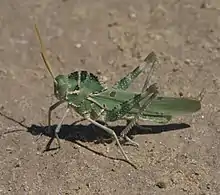
- Tropidolophus Thomas, 1873 - monotypic Tropidolophus formosus
Tribe incertae sedis
- Angaracrisoides Gong & Zheng, 2003
- Asphingoderus Bei-Bienko, 1950
- Atympanum Yin, 1982
- Aulocaroides Werner, 1913
- Aurilobulus Yin, 1979
- Austroicetes Uvarov, 1925
- Brancsikellus Berg, 1899
- Chloebora Saussure, 1884
- Chondronotulus Uvarov, 1956
- Chortoicetes Brunner von Wattenwyl, 1893
- Crinita Dirsh, 1949
- Cyanicaudata Yin, 1979
- Diraneura Scudder, 1897
- Dittopternis Saussure, 1884
- Elmisia Dirsh, 1949
- Eokingdonella Yin, 1984
- Eremoscopus Bei-Bienko, 1951
- Eurysternacris Chopard, 1947
- Fitzgeraldia Uvarov, 1952
- Flatovertex Zheng, 1981
- Granada (insect) Koçak & Kemal, 2008
- Homoeopternis Uvarov, 1953
- Humbe (insect) Bolívar, 1882
- Jinabia Uvarov, 1952
- Kinshaties Zheng, 1977
- Leptopternis Saussure, 1884
- Mecistopteryx Saussure, 1888
- Morphacris Walker, 1870
- Nepalacris Balderson & Yin, 1987
- Oreacris Bolívar, 1911
- Promesosternus Yin, 1982
- Pseudaiolopus Hollis, 1967
- Pycnocrania Uvarov, 1941
- Pycnodella Descamps, 1965
- Pycnodictya Stål, 1873
- Pycnostictus Saussure, 1884
- Qualetta Sjöstedt, 1921
- Rashidia Uvarov, 1933
- Tibetacris Chen, 1964
- Tmetonota Saussure, 1884
- Zimbabwea Miller, 1949
- †Mioedipoda Stidham & Stidham, 2000
- †Nymphacrida Zhang, Sun & Zhang, 1994
- †Oedemastopoda Zhang, Sun & Zhang, 1994
The genus Cibolacris was originally placed in Oedipodinae, and later moved to Gomphocerinae. The genus Stethophyma is traditionally included in Oedipodinae, but North American authors in particular sometimes place it in the Gomphocerinae or Acridinae. Some authors place all members of Oedipodinae within the subfamily Acridinae, and there has been much confusion and debate about the limits and relationships of the two subfamilies. [8] [9] [10] [11]
External links
 Data related to Oedipodinae at Wikispecies
Data related to Oedipodinae at Wikispecies Media related to Oedipodinae at Wikimedia Commons
Media related to Oedipodinae at Wikimedia Commons
References
- Orthoptera Species File (retrieved 28 January 2018)
- Walker F (1871) Catalogue of the Specimens of Dermaptera Saltatoria in the Collection of the British Museum Supplement: 102
- Hippopedon at Orthoptera Species File Online
- Parapleurini at Orthoptera Species File Online
- Lactista at Orthoptera Species File Online
- Sphingonotus at Orthoptera species File Online
- Cibolacris at Orthoptera Species File Online
- Oedipodinae at Orthoptera Species File Online
- Daniel Otte, 1982, 'The North American Grasshoppers, Volume 1: Acrididae: Gomphocerinae and Acridinae', Harvard University Press. ISBN 9780674626607
- DCF Rentz, RC Lewis, YN Su & MS Upton, 2003, 'A Guide to Australian Grasshoppers and Locusts', Natural History Publications (Borneo). ISBN 983-812-074-X , ISBN 978-983-812-074-6

